Monthly Archives: Mai 2022
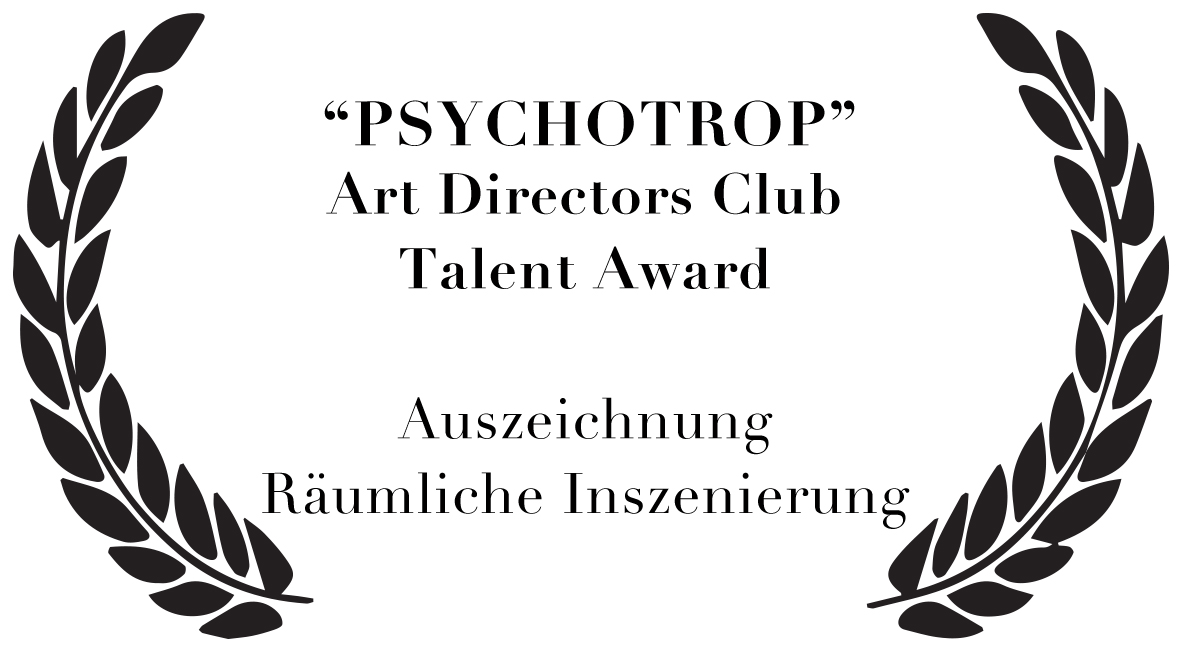
Der Art Directors Club hat getagt. Es gab einen silbernen Nagel und zwei Auszeichnungen. Eine davon ist Psychotrop-shifted reality. Die interaktive Medieninstallation der Hochschule der Medien, Studiengang Audiovisuelle Medien, Studioproduktion EventMedia hat in der Kategorie: Künstlerische Arbeiten Bereich: Experiment eine Auszeichnung erhalten. Dieses Jahr wurde weder Gold, noch Bronze vergeben.
Worum geht es denn bei dieser Installation? Wie fühlt man sich wenn man halluzinogene Substanzen eingenommen hat? Wie verändern sich Farbe, Form, Bewegung, wie scharf ist das Gehör?
Dafür wurden Probanden interviewed und aus den Informationen wurde eine interaktive Installation entwickelt. Es ist ein geodätischer Dom, die Dreiecke werden unterschiedlich bespielt, gleichzeitig vermittelt der Ton die Wahrnehmungsverschiebung der auditiven Eindrücke.
Der Erlebnisraum ist intim. Die Besucher*innen legen sich auf Sitzsäcke, der Blick ist in die Kuppe gerichtet. Vor ihnen, in angenehm greifbarer Entfernung befinden sich die federnden Tentakel der Interaktionsschnittstelle. Es sind 18 an der Zahl mit einem Endknöpfchen als stilisierte Nervenbahnenden. LED-Streifen, die zunächst auf dicke Aludrähte montiert und anschließend in flexible Silikonschläuche geschoben wurden, bilden den Körper.
Und in diesem Umfeld erleben die Besucher*innen die Reise der Sinnenverschiebung.
Wir gratulieren.
Beitrag von Prof. Ursula Drees
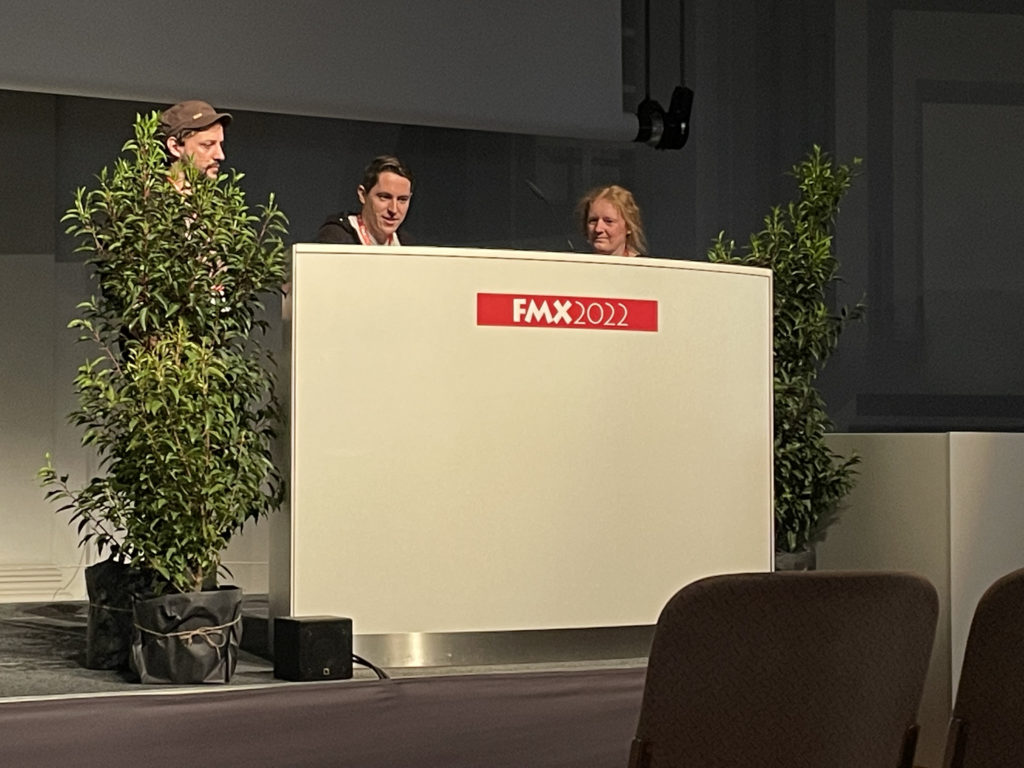
Chang Chi and the Legend of the Ring a Marvel Movie: Trixter and the Mythical Beasts.
It is a US martial arts fantasy film. It is about a Chinese legend, 10 magic rings, identity and the defence of the good.
A variety of mythological characters are brought to life. It begins with the exceedingly cute „Morris“. He is a supporting actor, a side kick for the main character and has a surprising and irritating physiognomy: 6 legs , 4 wings , lots of skin, lots of feathers, fluffy fur and lots of muscles, but no face. The briefing says: cuddly and cute.
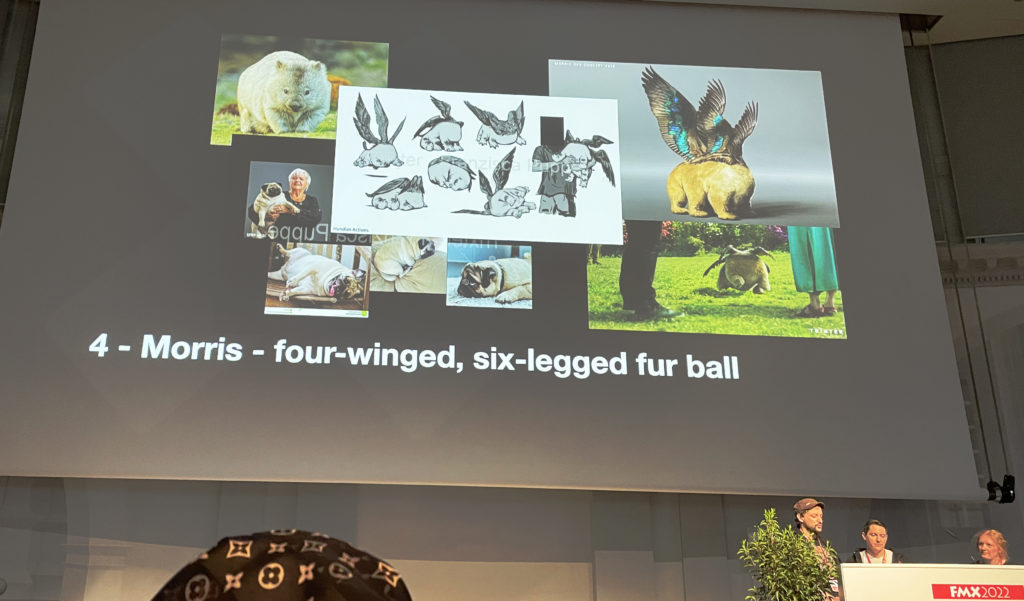
Morris is irritating. A little animal the size of a bulldog. It has no eyes, no nose, no mouth, no ears. It can’t taste, smell, hear or see. What can it do? The creatives of Trixter mentioned this fact as a challenge for their profession. Namely, to develop a cute little furry animal that must not be able to do anything. That is even adorable and so cute that the audience does not notice that they are fascinated by a creature that cannot live and should not live like that. The message Morris carries is easily broken down to: „I don’t need anything except human love. I don’t need to eat, I don’t need to breathe, I don’t need to taste, I don’t need to empty myself, I don’t need to be cared for. I am there, behaving like a young puppy dog, I am happy and dumb, I want to be protected, I give my life for that“. This is an animal, even if it is a mythical creature, being denied will and perception. Why are such creatures sold to the audience? Who came up with the idea? Why should there be an animal without a head and sensory perceptions?
Who is responsible for the content? Are the artists partly responsible? Or are they workers who understand the technique, the craft and give a face to such performances? It is a despicable idea and yet it must be given a delightful form and façade and given life.
For what Trixster has done is phenomenal. The movement, musculature, skeleton, functionality, fat, skin, fur are deceptively real. Viewers can fall in love with this creature.
The creatives of Trixster flex their muscles. It is for no reason that this studio is an Oscar winner. Back to our dubious character. He has the already mentioned six legs. The paws resemble those of bear cubs. Everything about this character is puppy-like. His behaviour is derived from Bulldogs, Sheepdogs Golden Retrievers. The voluptuous rolling in the sand on his back, the clumsy stumbling, the exuberant movements when running, jumping, sitting, everything is a bit awkward, just like puppies.
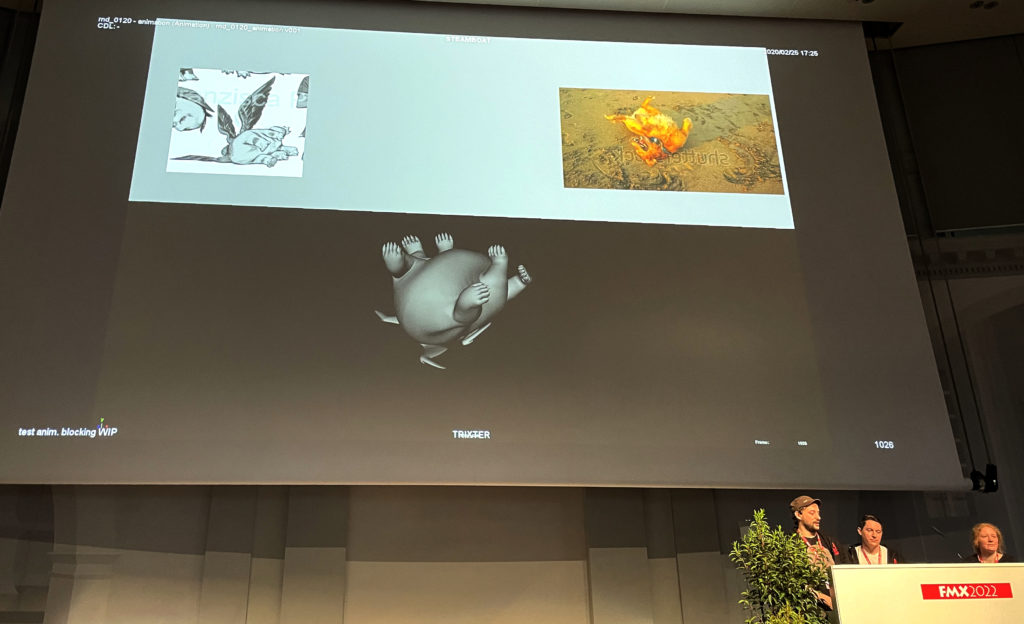
The character is built classically from the inside out. First the skeleton. This is where bones, ligatures, joints, type of movement, abilities and limitations are defined. Then the muscular system is added, a layer of fat is placed on top, followed by the skin. Everything is finished off with a voluminous, very soft-looking layer of fur. The legs are short, the torso rather chubby and shows no further definition.
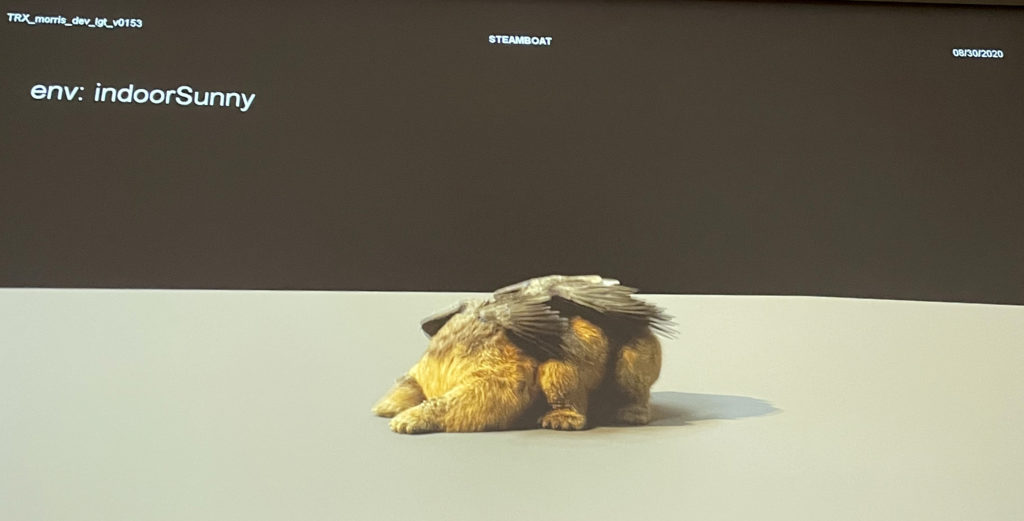
On the back are the four wings. They shimmer in blue and green tones in some places. The function of these wings is not to fly, but to convey moods through gestures. Morris does not bark, does not snort, does not breathe, but he sometimes creates a beeping sound.
Exact research of motion sequences and studies are required for the creation of such a character…. Motion tracking is sometimes used, but in many cases it is the close observation skills of the creators. We know four-legged dogs, so the creatives had to think about the two extra legs. Is the movement accentuated by double hind legs or is the forward movement emphasised? The decision goes to the hind legs and so this lovable character hops and jumps through the film. Of course, he is also loved. For he is one who likes to jump on the lap, wants to be cuddled. He has no other function. How does the fat shift, how does the fur behave under a hand? It’s about many detailed special conditions. How does the fur shine when it is implemented from the virtual situation into real film – these questions are answered.
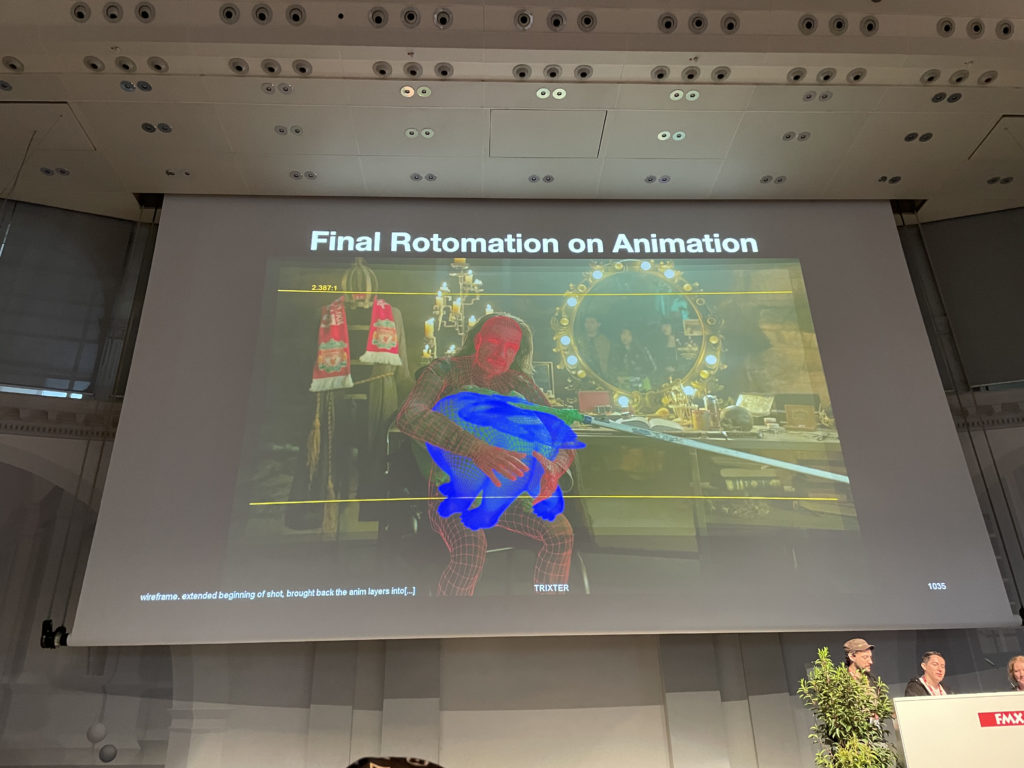
A very high degree of reality is evoked. The accuracy and the perception of detail are overwhelming. Movements are fluid, consistently smooth and elegant. Surfaces adjust precisely to changing positions. It is convincing. Only behavioural scientists would detect too much softness in the movements at some points. Nature is often more complex, viewers might know, because if you watch dogs or horses closely, you will notice many quick micro-movements that marginally break the flow of the softness. The virtual elegance of movement makes the fantasy figures look more harmless. The unpredictable is not captured. But then, it’s not supposed to.
It is an overwhelming amount of movements of the whole body, special gestures and expressions that are conceived and made possible. Stretch, jump, stand up, straighten, walk, stand, run, rest, graze, fall, roll, limp, play, enjoy, yawn, eat, drink, spin…. an endless list. There is detailed work being done.
It would be interesting to compare the amount of joints, tendons, cartilage, muscle etc. from an animal to that of fantasy creature.
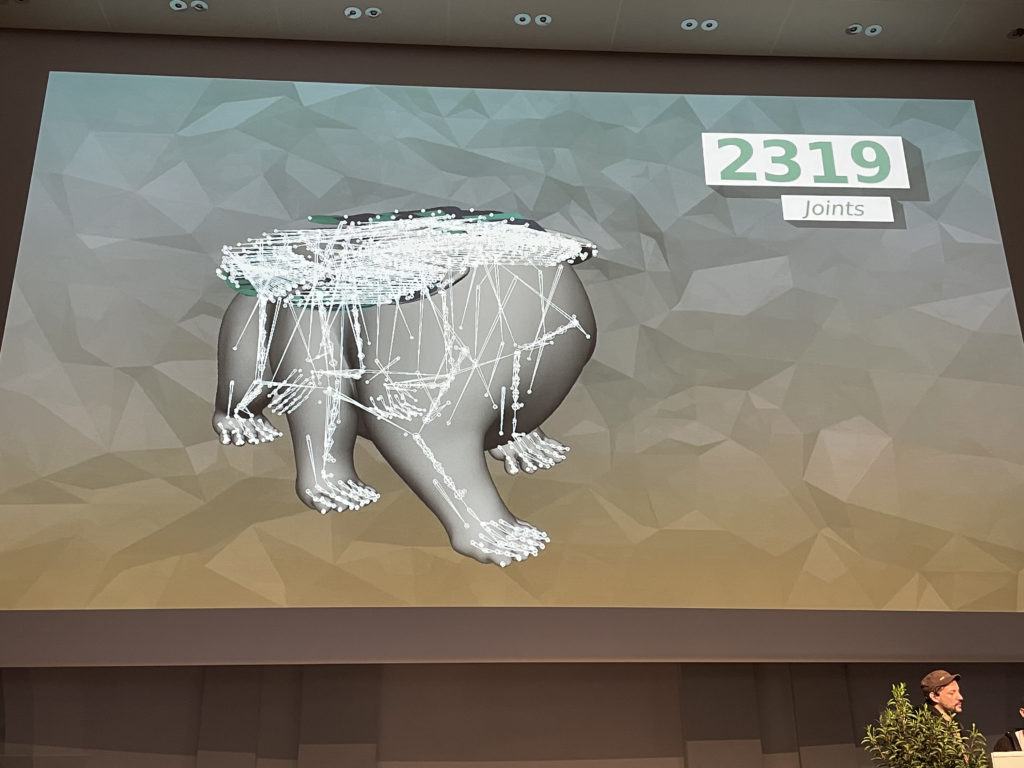
The presentation does not stop with Morris. The other characters, such as the multi-tailed snow fox, a kind of iridescent horse, huge village dogs cross-bred to lions and sabre tigers, or the Goliath-like Hulk are introduced in the same way. First they talk about the basic structure, then about movement sequences, and about how they fit into the rest of the film. Numbers are mentioned, the sheer amount of work is brought into focus. There are so many challenges to overcome. The audience listens breathlessly. Just the question of how the lighting situation of a virtual character is exactly adapted to a real situation. What about Pure black matching? It’s a bottomless pit.
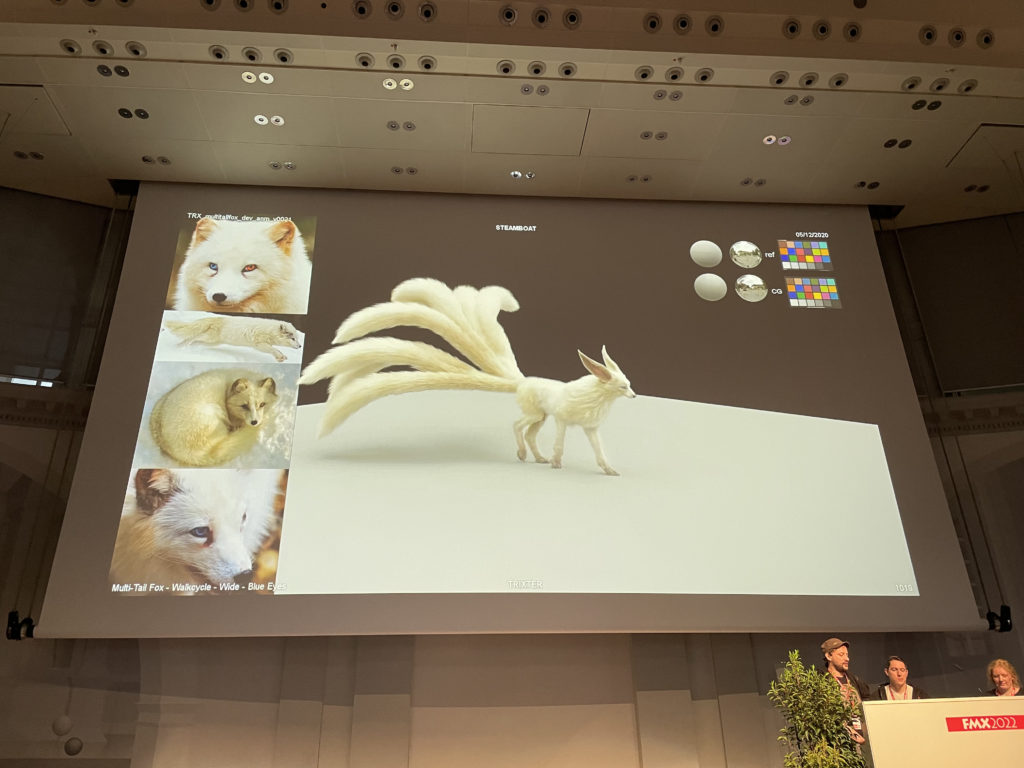
The professionals from Trixter give a detailed insight into their work. At the end there is clapping, some shouts of joy, but probably from Trixter employees. They rightly celebrate the result and their colleagues.
A final word, however, on the content of the film. Quite detached from the performance from the special effects department: The author would like to reflect on the quality of the content of today’s films. In this context, we may refer to a speech by John Landgraf, the boss of FX, during an address he gave at the Television Critics Association press tour in the summer of 2015. At that time, the quality and sheer quantity of TV series was already being reflected upon.
Landgraf reflects on the quality of the scripts and notes that they lead to results that are watchable but unremarkable. And asks for those that are wonderful and innovative, weird and special and provocative. The market releases film after film, almost one too many, and the quality is not bad, it is often good, but not outstanding. He explains it with the immense time pressure to produce on a daily basis. But the new is not discovered in this way. More often the well-known scriptwriters are called upon. But this puts similar stories and plays on the market. Viewers are willing to watch well-produced, technically excellent media, but at some point it gets boring.
„To be clear, there are plenty of stories and plenty of people, many of whom are underserved and underappreciated and rarely heard. But he’s right that the finding of them (and the hiring and the choosing and the training and especially the nurturing and supporting and protecting of talent for a good outlet that wants to do those things) does take time and commitment. And while everybody making more stuff should lead to more chances for underrepresented voices to be heard, it can easily lead to the opposite: going back to the same people over and over again because it’s easier and faster and it feels safer, and you don’t have all day to go beyond your existing Rolodex. And when money is hard to come by, it’s often the new voices that are sacrificed first.“
The film industry is repeating itself, albeit with better technology and great special effects, but that no longer sufficiently distracts from the sometimes far-fetched filmic content. Even the super-professionals from Trixter can’t fight this.
Post by Prof. Ursula Drees
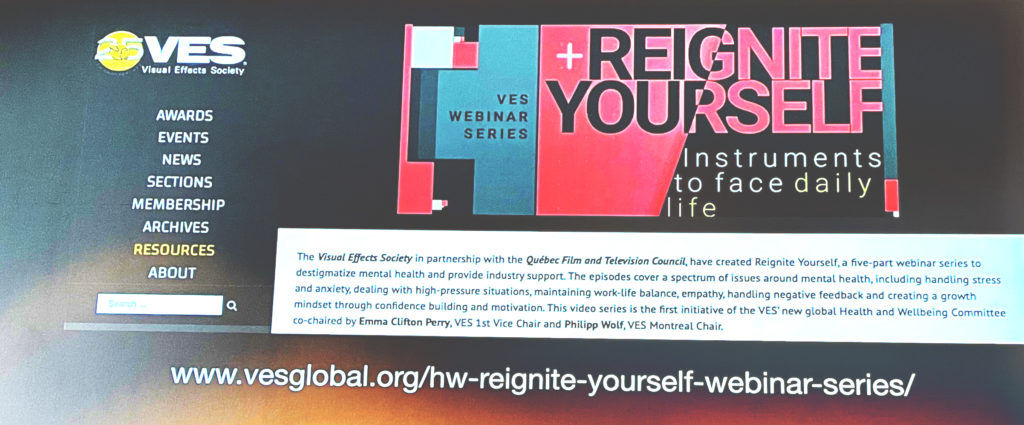
Visual Effects Society Webinar Serien: Reignite Yourself: Instruments to face daily life
Laurie Blavin as Global Head of Talent Acquisition of Scanline
www.vesglobal.org/hw-reignite-yoursself-webinar-serien/
About labour and conditions in Creative Industries:
In their studies, students are taught the tools of the trade and that they intend to work in a highly competitive labour market. And that means they have to be better than the others. They have to work more, work longer, work harder. And they have to do it for lower wages.
Artists do not necessarily live for external rewards, such as salary, bonuses, company cars or other compensation. Artists work because they are intrinsically motivated. They are convinced of a certain thing, they feel a vocation. It is not a profession, it is a calling. They take pleasure in what they do. And put everything they have into it. That makes them vulnerable. Those who throw their whole being into something will also experience all the conditions with their whole being. These people are involved. They feel lust. If lust is not controlled, it becomes obsessive. As a result, the young creatives in the creative industries are excellent material to exploit.
This industry is precarious and that will only change slowly in the future. Young creatives need to understand that their work must be rewarded accordingly. That they are not alone. That they are not just artists, agents and PR machines, but that they have rights.
They need to stop closing their eyes to reality and stop spreading the myths that exist in this industry and proudly spread the stories that carry hero status. Stories of insanely long hours, of all-consuming concentration, of inhospitable working environments, of ultimately experiencing a happy ending and delivering an exceptional product. They make martyrs of themselves: surviving and winning against all the odds of this industry.
Young artists should recognise their value and convert it into money. And not just in money, but translate it into work life balance parameters.
Whether this ideal can be realised now remains questionable. Because the heroic epic outshines reality. The young artists want to believe in these stories and be part of them. Even if this leaves them burnt out after a few years. Even if they might only wake up then.
Until then, they are convinced that they have no rights. That they have to survive in precarious work environments. That they have to take whatever is offered to them and only become stronger as a result.
And until that is understood, industry will remain as it is.
Post by Ursula Drees
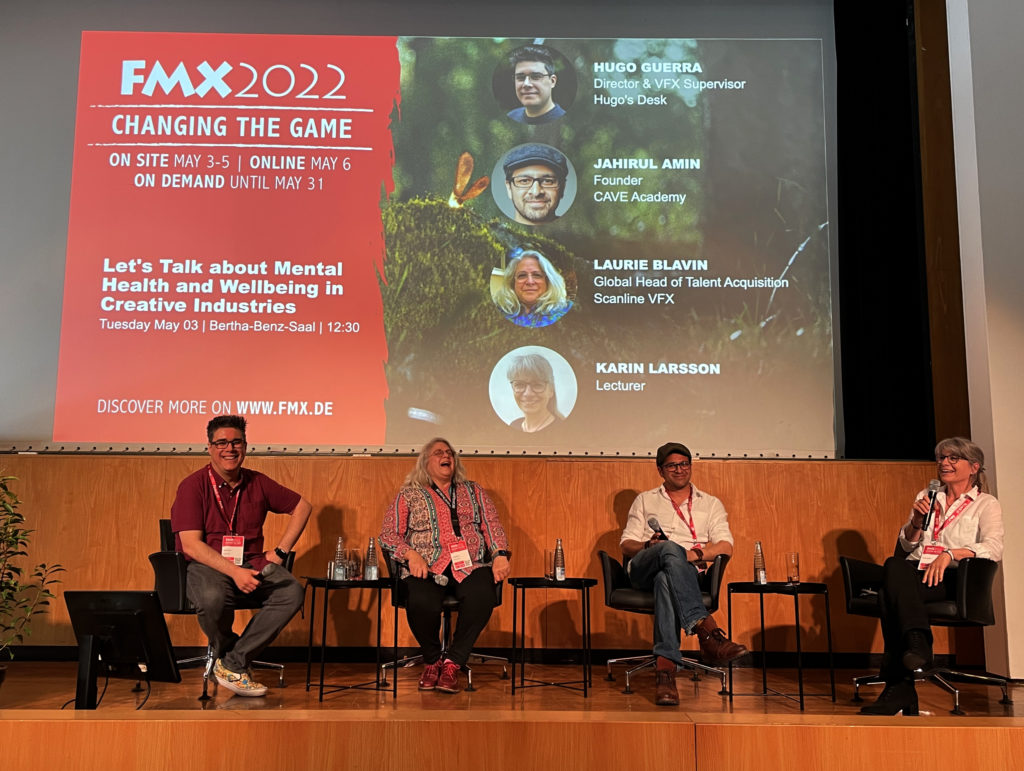
I am sorry: It is a long read.
Sometimes there are panels that are so important that no one notices. They are life-saving. This panel from the Social Impact Category called „Lets talk about Mental Health and Wellbeing in Creative Industries“ is just such a panel.
Hugo Guerra (Hugo’s Desk), Laurie Blavin (Scanline VFX), Karin Larsson, Lecturer and Jahirul Amin (CAVE Academy) talk about the long-tolerated problems of employees in the creative industries
The four speakers know their stuff.
Laurie Blavin as Global Head of Talent Acquisition of 1300 employees. A huge business with locations all over the world. Hugo Guerra. His filmography is so long that the author gets bored just scrolling down his portfolio on the website. He has been everywhere. At The Mill, Fire Without Smoke, Sony Playstation or Rebellion Games. Jahirul Amin. He is founder of CAVE Academy, which specialises in VFX, animation and games training for the creative industry. Before launching CAVE Academy, he was the VFX Trainer at DNEG London, and before that, a lecturer in Computer Animation at Bournemouth University. Karin Larson has a PhD in psychology and has worked in the USA for many years. She is a lecturer at the Filmakademie Baden-Württemberg in Ludwigsburg and covers the topics how to build a successful team, solve problems in team situations and be able to enjoy a productive team. She specialises in the needs of employees in the creative industries.
All four of them know what they are talking about and illuminate the topic from many angles, be it from the point of view of the people concerned to that of the psychologists.
Questions are asked such as „How can you stand working in this industry? This stress, the hard deadlines, the long hours, the working conditions and sometimes environments?“
Most people can’t take it. Concentration problems, health problems of too much sitting, the long hours where you have to be awake all the time. When you’re young you put up with it, but not so when you’re older.
People get sick, they lose themselves in work, they don’t find an end, they work more and more and finally they don’t know who they are, what they can do, what they used to be and what they want to be. They work, let themselves be driven by deadlines and demands until they simply collapse. It is an industry comparable to slave labour. 16 hours is no problem, so is weekend work, last minute time changes, nights without sleep at the computer and sleepless nights because you can’t switch off anymore.
How is it that an industry can provoke such reactions in its employees? Surely it is because of the glamorous side of this world. People work for the film industry. There are stars to be found there. Stars in every trade, be it cinematographers, actors, special effects artists, sound artists, costume etc. dreams are built here and it is from the fascination of the never before seen, lived, thought and dreamed that the creative industries thrive. They provide the food to break out of reality, to do a bit of escapism. Whoever plays in this industry is part of this entertainment machinery, full of artists and deviant professions and specialists. It’s like a secret industry, because most people don’t even understand what the titles and work units do and mean.
That’s why myths can be played with. At the conferences, young people stand on a podium and tell how they designed and produced this or that character. What it took to make a lifelike virtual character with wings, fur made of water particles or streams of fire or other fantastic attributes.
They talk about joints, rigging, how many studies were needed, which templates were necessary for motion tracking and what was thought of and done to integrate the light on the surface of a completely virtual art character into a real film scene. It’s a pleasure to listen.
You want to be fooled too much and become a part of it. One also wants to tell about the fact that one has made a tremendous effort, that one has not failed at problems, but that all of them have been solved. That the result yielded an OSCAR or an EMMY Award, that one had a part in such a production and appears in the credits. Fame and glory, unfortunately not enough money and time. It’s a kind of secret society. And as it is with such societies, many other aspects remain in the dark.
And so it is that it is almost a „badge of honour“ in the industry to have a burn out. The fact that burn-out is a serious mental illness that those affected carry with them throughout their lives and always have to deal with is not addressed. „That should not be the case. You have to keep your creativity alive, and that only works if you are healthy. So please: get away from the screen“. (Laurie Balvin)
The poor pay, the pressure to hand over creative work in bulk, to have the good idea, to be able to realise it accordingly with the manifold tools, to always have a solution ready. Perhaps it is the fear of not being noticed by the creative director or of receiving a crushing critique from the art director, only to be demoted as a consequence. (Hugo Guerra)
It is the dichotomy of wanting to go home after 8 hours of hard and concentrated work, to enjoy a private life. But that’s not easy, because all the other colleagues are still at their desks and computers. You don’t want to leave anyone behind, you don’t want to set boundaries. These industries exploit and the creatives let themselves be exploited. The young creatives go to the limit of their pain. They don’t have enough self-confidence yet to stand up for themselves. (Jahirul Amin)
In addition, there is often the family saga of the company. The workers are told that they are one big family. Families share pain and joy. People are there for each other. But is that true? Agencies, companies want to, have to make turnover. The family story is used against the employees like in mafia structures. Either you are one of us, or you are against us.
There are a lot of circumstances that lead to employees giving up on themselves. And realise far too late that they no longer have any friends, that they don’t do any sport, that they eat badly, maybe even develop moderate illnesses due to bad posture after 17 hours of sitting and staring at the computer, that they wake up in the middle of the night thinking about work, that they have no motivation, that they only want to be at work. Because that is where they always are, where they are at home. People forget what it means to clear their heads, maybe to read, or to go for a walk. Or even join a sports club, raise a family, visit friends and pop in for a coffee or tea without pressure. To experience time. Or to enjoy boredom.
The panel deals with this problem.
Karin Larsson tells us that a position has been created in the productions of the film academy that deals with the welfare of the participants. An astonishing statement in the eyes of the author. Almost unimaginable, in fact. She reports that the artists are reminded to sleep, take breaks, get air, eat and experience community. Is it not
unfortunate that we are in a world of work where one has to be reminded of such fundamental needs?
Yes it is. It is perhaps due to the nature of the artistic profession. Intrinsic motivation drives action, it’s no longer mainly about money, a big company car or the bonuses. It’s about art, culture, the greater good. That drives employees and that is very fertile ground for exploitation.
In this panel, all that is spoken and named. What has a name gets a face. There are ways out. There are already support organisations such as Health and well-being resources in the visual effects Industry. In webinars, the silverbacks talk about their experiences in the creative industries, how they coped with the problems, what solutions they developed.

www.vesglobal.org/hw-reignite-yoursself-webinar-serien/
Hugo Guerra: „It was great to work 16 hours and more. You were even admired and praised for it. At the same time, you feel like a working robot. Physical, mental and psychological problems are simply pushed away. Is it good to sleep so little? Isn’t it cool to work as much as possible?“
Young women artists are finally being told that this kind of work mentality is not to be supported. It is being talked about at all. This panel creates an awareness. Creates a community.
The audience hears that their work is worth a lot. That the industries are scrambling to find people. (Why is this hand-wringing, I wonder? Author’s note: because the working conditions and wages are so horrendous maybe?)
It is said that social media contributes a lot to the fact that artists see themselves as individual cases. It is no longer seen that many people in the creative industries have similar experiences. That it is good to form communities and not to strive for likes. Not to scroll up and down somewhere, only to experience later that everything but relaxation and recreation has been achieved? That time is gone, escapism works. Brave new world.
We are there! Now let’s change it. Thank you for this panel.
Post by Prof. Ursula Drees
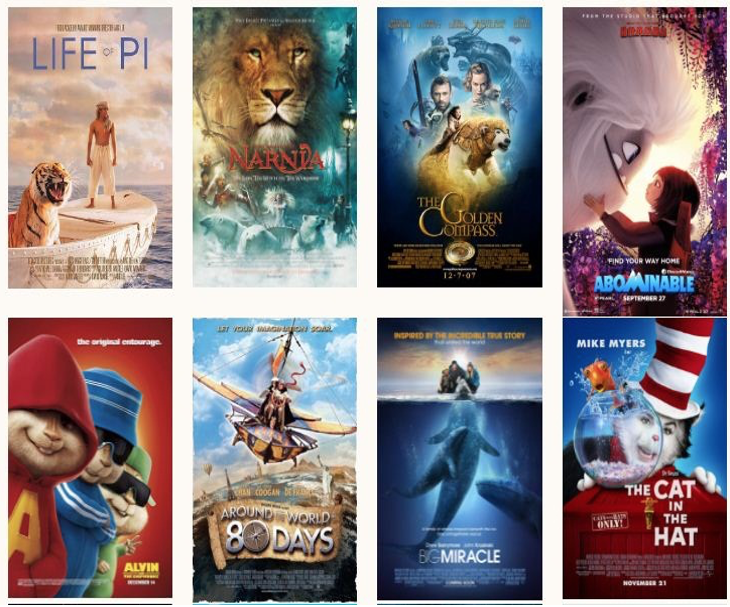
Saraswathi ‘Vani’ Balgam is an Indian born writer, director, self-taught photographer and filmmaker. Her Indian and Southeast Asian cultural heritage, along with her experiences and memories from being an avid global traveller, help her to portray common humanity and unique journeys within her characters and stories.
Her exposure to the film industry started from a young age when her father started a 2D animation studio within their family home, with an aim to create films which involved rich Indian culture and heritage for a global audience. This foundation of creativity from her father, as well as her mother who is also vividly creative.
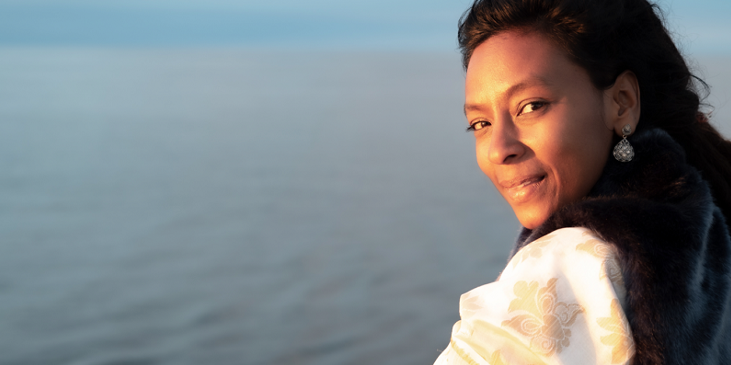
While Vani started her career as a business development executive for CMM Studios Limited in Mumbai, India, she slowly rose through the ranks within the Southeast Asian film scene, and was appointed as Executive Director and Founder of the Rhythm and Hues Asian Studios. While executive director, she managed employees across four studios in Kuala Lumpur, Mumbai, Hyderabad, and Taiwan which produced VFX for many major Hollywood films, such as ‘Life of Pi’, and ‘The Golden Compass’, which each won Rhythm and Hues Studios the Academy Awards for Best VFX in 2013 and 2008 respectively. Vani also served as the Head of Creative Management and Training for Dreamworks Studios in Shanghai, China.
Saraswathi Balgam founded Dancing Atoms Studio to create amazing stories with unforgettable and different characters. Vani encouraged other writers, directors, producers to create animation and direct animated VFX content since India has a lot of them stories to tell for audiences worldwide. Dancing Atoms has championed the Women Creators – Epic games Unreal programme.
In 2021 Vani wrote, directed and produced ‘Arising’. She tells the story of a young woman who has experienced sexual abuse in her workplace fights back with the help from her sisters and the #MeToo movement. The film was documented with footage of the LA women’s march in January 2018. This project was selected in the ‘Women’s International Film Festival Nigeria’ in 2022.
We are delighted to be interviewing her on Wednesday, May4th at FMX, immediately after her talk. This video post will be published a little later. For now, we’re diving headfirst into the FMX.
Post written by Luiza Noemi Bogya, Karen Reilly, Miklos Bajus

